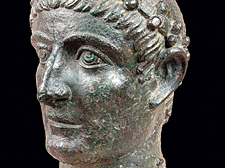|
|
 |
| |

Head of Constantine I, the Great, 325-330
Cast bronze, gilt
National Museum, Belgrade
Photo: Nebojša Bori? |
One thousand years of Byzantine beauty
John Evans joins in celebrating the art of a once powerful empire
A SPRAWLING mongrel empire is the description used for this enigma by historian and broadcaster Bettany Hughes in her recent BBC radio series Byzantium Unearthed.
The emphasis of Byzantium 330-1453, the Royal Academy’s major autumn exhibition, is on the beauty not the war-riven beast.
As such, it is not the place to examine a clash of civilisations. The single bit of military hardware is a sword, the relevance of which is the inscription, a plea for a blessing and protection from the Virgin.
Five years in the making, the exhibition, which opened on Saturday, comprises more than 340 items from micro-mosaics, ivories, enamels, gold and silverware, wall paintings and a number of remarkable icons.
Co-curator Professor Maria Vassilaki of the University of Thessaly at Volos, in Greece, says a chronological progression has been followed with nine major sections. These range from exhibits exploring aspects of Byzantine art from the origins of the “New Rome” under the emperor Constantine who established Constantinople from 330, to what Professor Vassilaki describes as icons from a monastery “… where Byzantium lives to this day”.
The Holy Monastery of St Catherine in Sinai has lent nine icons dating from the 11th to the 13th centuries, including the striking and unusual Icon of the Heavenly Ladder of St John Klimakos, which depicts the arduous climb facing the monks in their search for salvation.
It is based on the illuminated manuscript of The Ladder of Divine Ascent, an important work providing insights into the theology of art in the Orthodox Church.
No major exhibition of Byzantine art has been seen in the UK for half a century, and many of the works here (none from a private collection) have never been seen in this country before. It is the haggling and diplomacy which has brought the pieces together which explains the long lead-in time for the show.
Rare items from collections across Europe, the US, Russia and the Ukraine are included and great pieces from the San Marco Treasury in Venice, for example the Icon of the Archangel Michael from 12th-century Constantinople, silver gilt on wood, with gold, cloisonné enamel and precious stones.
The Metropolitan Museum of Art in New York has lent The Antioch Chalice. Now known to be from the first half of the 6th century, and from Syria, this silver cup in silver gilt shell, discovered in 1911, was for a time believed to have been the Holy Grail used by Christ at the Last Supper.
Byzantium 330-1453 covers the 11 centuries from its beginnings under Constantine and Justinian the Great to the fall of Constantinople to the Ottomans under Mehmed II.
But whatever the period, from the earliest days of the Christian Roman Empire, through those of iconoclasm, to the sack of Constantinople by the Fourth Crusade in 1204 and beyond, what shows through is a belief in the importance of art as a celebration for peoples who came to see themselves as God’s children.
•
|

|
 |
|
 |
|

